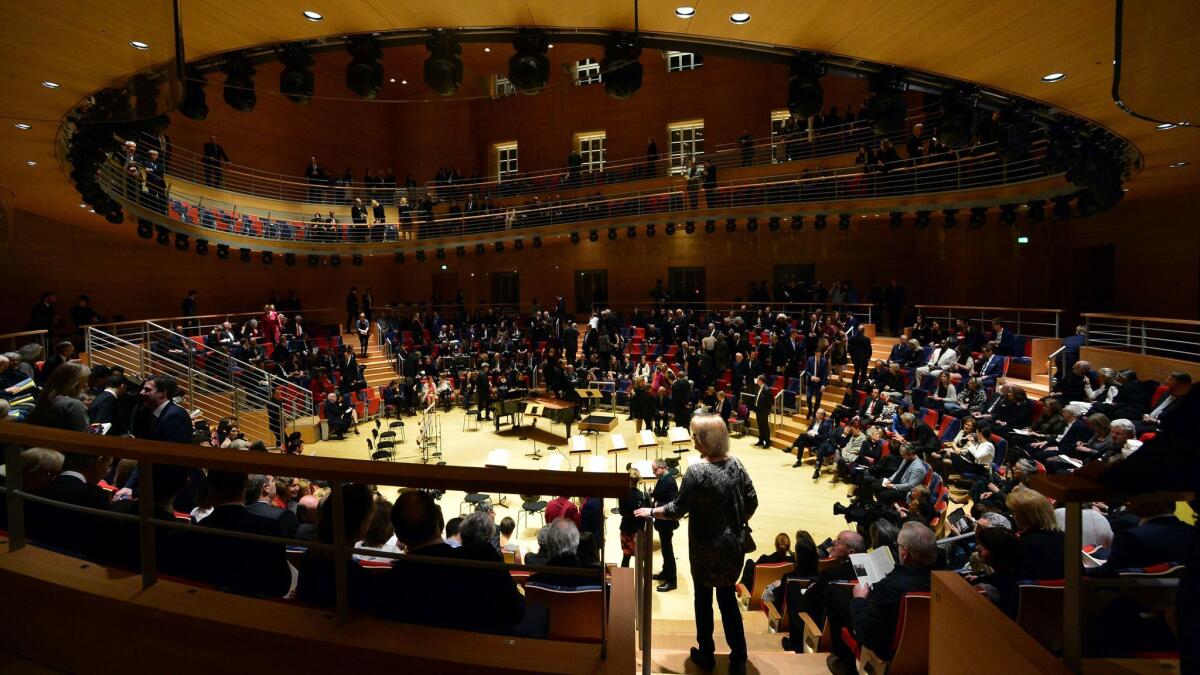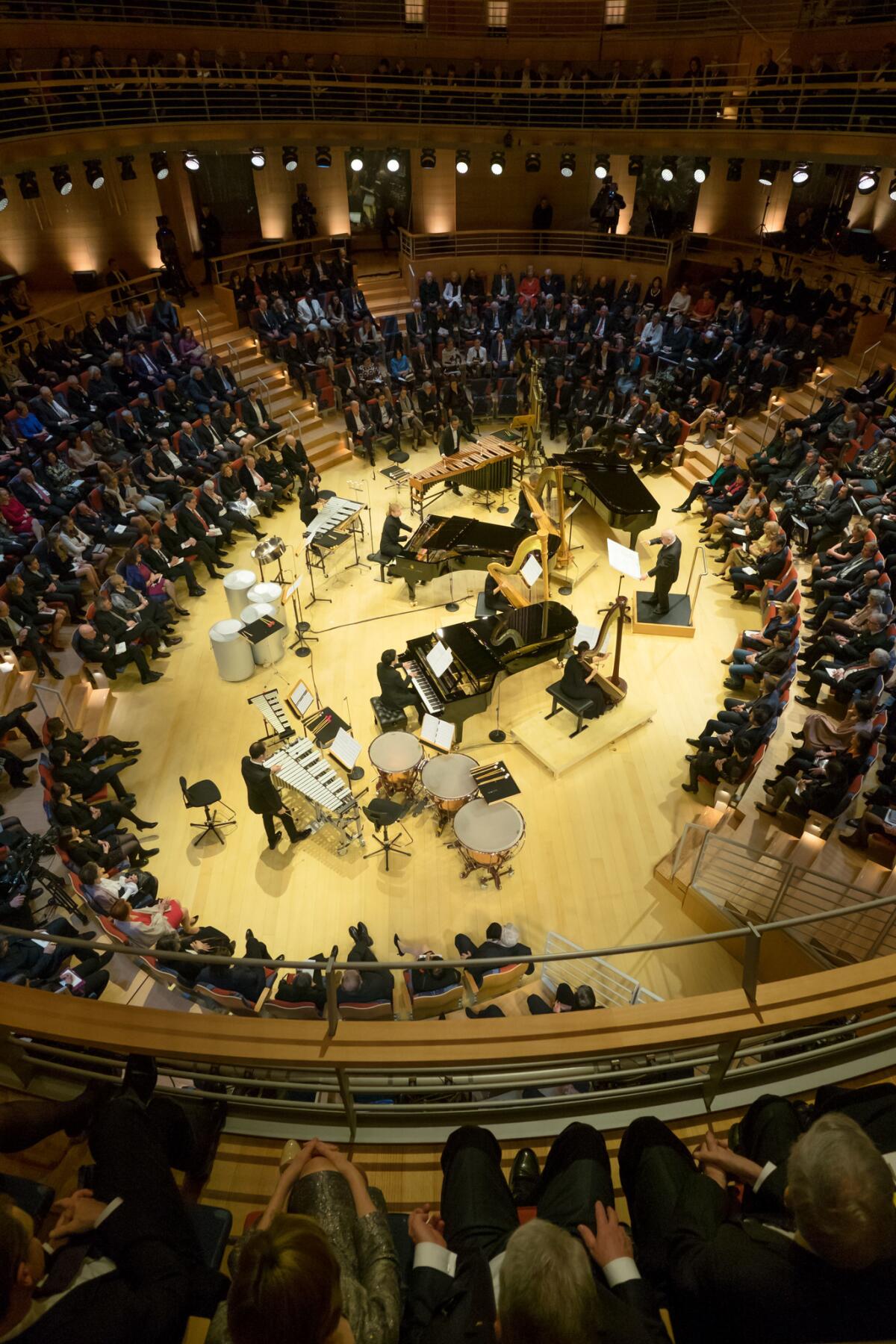Review: New Gehry concert hall in Berlin thrills with its sound — and its symbolism

The German city of Hamburg has become a media darling with its awesome Elbphilharmonie, a new concert hall that stands taller, cost more and is more gawk-able than any other. Berlin, however, now has the exact opposite in the graceful, airy, idealistic Pierre Boulez Saal, which opened here Saturday night. Rather than stand tall, it stands for something.
Pianist and conductor Daniel Barenboim conceived his seemingly modest 683-seat hall as part of the new Barenboim-Said Academy, where young Arab and Israeli musicians train together so that they might someday learn to work together. And the new hall is a place for music to visibly — and audibly! — make a powerfully public cultural statement.
To that end, the Walt Disney Concert Hall team of architect
The shape of this “Saal modulable” has its origins in an offhand circular sketch by Gehry that to me suggests a black hole. The analogy holds inside the building, which is composed of two slightly skewed ovals. One is the stage, surrounded 360 degrees by seats. Above the stage — higher than Gehry wanted but where Toyota insisted would be acoustically preferable — are two undulating rings of seats.
Feeling like an astronaut hovering above Saturn, I sat on the lower ring. The ledge is tilted to discourage putting your program on it and to encourage leaning forward. Once you begin to lean, the music has a kind of sonic gravitational pull for which we don’t yet have an everyday acoustics adjective. Vivid, intense, dramatic, resonant, immediate, intimate — none will do, even if you string them together.

A hall in the round affords another marvel of simultaneously creating a communal effect, along with providing a singular perspective visually and aurally. No one hears or sees quite the same thing, while at the same time, musicians and audience feel as though we are in it together.
This all goes back to Boulez, the revolutionary composer and conductor who died a year ago at age 90 and for whom the hall and ensemble have been named. When he became music director of the New York Philharmonic in 1971, Boulez began to reimagine the concert experience, creating special “rug concerts” for new music in various spaces where the audience would sit on the floor, creating an atmosphere of openness to new experiences by breaking down formal barriers and expectations.
It was at a rug concert in New York where Gehry first met Boulez, beginning a long friendship. Gehry told me at intermission Saturday that Boulez Hall would be perfect for rug concerts, because the seats downstairs can be electronically retracted to create a large open stage.
For Barenboim, who began performing with Boulez in the 1960s and who also became close to the composer, the concept of openness has had particularly broad implications musically, culturally and politically. He and Palestinian American literary scholar Edward Said founded the West-Eastern Divan Orchestra in hopes that giving Arab and Israeli student musicians the opportunity to play together might lead to understanding, if not necessarily friendship.
On Saturday, the players provided a conspicuous multicultural mix of students and professional symphony musicians (if unexpectedly short on women), and the program was intended not only to show off the hall and the ensemble but also to give a hint of what the venue will come to represent. Barenboim has programmed a busy opening four months with wide-ranging programs that include a multi-year survey of all of Schubert’s songs, mixed bills of modern music and standard repertory and a considerable emphasis on music, classical and traditional, from Arab countries.
Star performers will abound — including pianists Martha Argerich,
The president of Germany, Joachim Gauck, smiled at the crowd as he took his seat and casually said good day. Prime Minister
Throughout the evening, Barenboim kowtowed to no one. He began by conducting a little-known Boulez fanfare originally written in 1987 for the Menil Collection in Houston. Seven brass players stood on high at either side of the hall. From my seat, quite near one group, I got a thrilling headphone effect, although I could also feel the entire hall filling up with all-consuming resonance.
The Schubert song project began with “Der Hirt auf dem Felsen,” featuring soprano Anna Prohaska, clarinetist Jörg Widmann and Barenboim. Heard from on high, voice and clarinet were like answering echoes of each other, transforming the space into something seemingly vast. Also at my altitude, Barenboim’s piano dominated Mozart’s Piano Quartet in E-flat, the hall seemingly tailor-tuned for his plum-rich tone.
ARCHITECTURE: Critic Christopher Hawthorne's take on Pierre Boulez Hall »
Berg’s Chamber Concerto for piano, violin and winds was a moving symbol of the next generation, the soloists being Barenboim’s son, Michael (who is concertmaster of West-Eastern Divan Orchestra), and the late Edward Said’s nephew, Karim Said, a young Jordanian protégée of Barenboim. The performance was strongly dramatic, the acoustic pulling a listener into Berg’s emotionally and musically complex language with, for me, unprecedented physicality.
The third section of the program began with a clarinet solo by Widmann, who is also one of Germany’s most sought after composers. (He wrote an oratorio for the opening of the Elbphilharmonie and has a commission from Barenboim coming up for the Boulez Hall). I was told by some seated downstairs that his Fantasie was an intriguingly mysterious disembodied voice, since they couldn’t see the clarinetist stationed on the upper ring. Those of us seated practically next to him had the considerable pleasure of listening as if from inside the clarinet bell.
The biggest piece of the night was Boulez’s late, 40-minute “Sur Incises” at the end. Three harps, three pianos and three percussionists set the hall resonating like there would be no tomorrow. There are points where Boulez creates intricate rhythmic patterns that circle one another, slightly off, just like the ovals in the hall.
Here Barenboim went for drama in intellectual music, appealing to what he calls “the thinking ear.” The mostly young musicians — some of whom would be banned from giving voice to Boulez in the U.S. because of their passports (Barenboim, too, given that he holds a Palestinian passport, and if he were to show that rather than his Israeli one) — were mightily impressive. The German president joined the standing ovation.
The Elbphilharmonie is the concert hall that Hamburg needs. The Pierre Boulez Saal is what the world needs.
ALSO
What does one critic hear at the new Elbphilharmonie? The sound of the future
The Toyota effect: 30 years later, one man's acoustic designs still rule how we hear music
L.A. Phil delivers a dazzling reimagining of 'Nixon in China'
The biggest entertainment stories
Get our big stories about Hollywood, film, television, music, arts, culture and more right in your inbox as soon as they publish.
You may occasionally receive promotional content from the Los Angeles Times.








